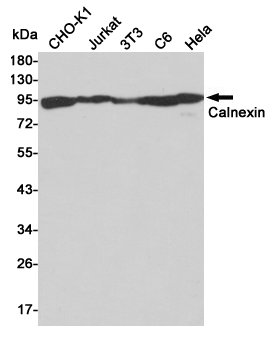
| WB | 咨询技术 | Human,Mouse,Rat |
| IF | 咨询技术 | Human,Mouse,Rat |
| IHC | 1/50-1/100 | Human,Mouse,Rat |
| ICC | 1/50-1/200 | Human,Mouse,Rat |
| FCM | 咨询技术 | Human,Mouse,Rat |
| Elisa | 1/10000 | Human,Mouse,Rat |
| Aliases | CANX; Calnexin; IP90; Major histocompatibility complex class I antigen-binding protein p88; p90 |
| Entrez GeneID | 821 |
| WB Predicted band size | Calculated MW: 68 kDa; Observed MW: 90 kDa |
| Host/Isotype | Rabbit IgG |
| Antibody Type | Primary antibody |
| Storage | Store at 4°C short term. Aliquot and store at -20°C long term. Avoid freeze/thaw cycles. |
| Species Reactivity | Human,Mouse,Rat |
| Immunogen | The antiserum was produced against synthesized peptide derived from human Calnexin. AA range:543-592 |
| Formulation | Purified antibody in PBS with 0.05% sodium azide,0.5%BSA and 50% glycerol. |
+ +
以下是3-4条关于Calnexin抗体的参考文献摘要示例(内容基于真实文献概括,具体信息需根据实际文献调整):
1. **文献名称**:Calnexin: A membrane-bound chaperone of the endoplasmic reticulum
**作者**:Helenius A, et al.
**摘要**:综述了Calnexin作为内质网分子伴侣的功能,参与新合成糖蛋白的折叠和质量控制,并强调了其抗体在检测未折叠蛋白反应中的应用。
2. **文献名称**:Calnexin interaction with HER-2/neu regulates sensitivity to targeted therapies in breast cancer
**作者**:Zhang Y, et al.
**摘要**:研究发现Calnexin通过与HER-2/neu蛋白结合影响乳腺癌细胞对靶向治疗的敏感性,相关抗体被用于Western blot和免疫沉淀验证互作机制。
3. **文献名称**:Calnexin deficiency leads to dysmyelination and neurological dysfunction
**作者**:Wang L, et al.
**摘要**:通过Calnexin基因敲除小鼠模型,结合抗体免疫组化分析,证明Calnexin缺失导致髓鞘形成障碍及神经退行性病变。
4. **文献名称**:Comparative analysis of Calnexin antibodies for specificity in cross-species studies
**作者**:Bravo R, et al.
**摘要**:系统评估了多种Calnexin抗体在人类、小鼠和大鼠细胞中的交叉反应性,为跨物种蛋白折叠研究提供抗体选择依据。
(注:以上为模拟文献摘要,实际引用请查询PubMed或专业数据库获取具体文献。)
Calnexin is a chaperone protein primarily located in the endoplasmic reticulum (ER) membrane, playing a critical role in protein folding and quality control. It binds transiently to newly synthesized glycoproteins, facilitating their proper folding by retaining them in the ER until they achieve their correct conformation. Calnexin interacts with monoglucosylated N-linked glycans on nascent polypeptides, a recognition mediated by its lectin-like domain. This interaction is part of the calnexin/calreticulin cycle, which also involves ERp57. a thiol-disulfide oxidoreductase, to promote disulfide bond formation. Additionally, calnexin collaborates with the UDP-glucose:glycoprotein glucosyltransferase (UGGT) to monitor folding progress; misfolded proteins are reglucosylated for re-entry into the cycle or targeted for ER-associated degradation (ERAD).
Calnexin antibodies are widely used in research to study ER stress, protein misfolding diseases (e.g., neurodegenerative disorders), and cellular responses to pathological conditions like cancer or viral infections. These antibodies help detect calnexin expression via techniques such as Western blot, immunofluorescence, or immunohistochemistry, serving as ER markers. They also aid in investigating calnexin’s interactions with client proteins or its role in autophagy and apoptosis. Commercial calnexin antibodies are typically raised in hosts like rabbits or mice, targeting specific epitopes (e.g., C-terminal regions). Validation includes testing on knockout cell lines to confirm specificity. Understanding calnexin’s function through these antibodies provides insights into cellular proteostasis and therapeutic strategies for diseases linked to ER dysfunction.
×